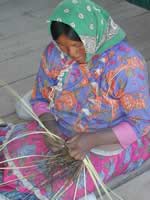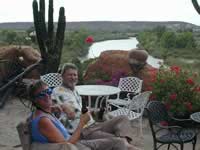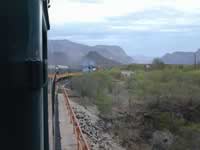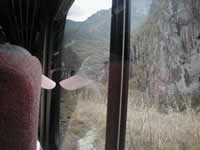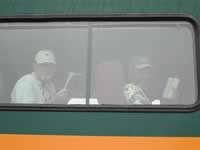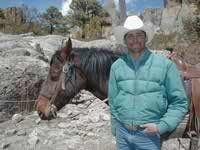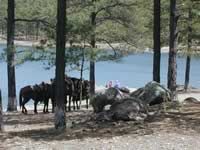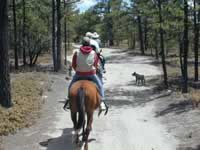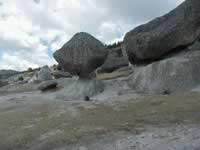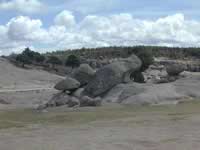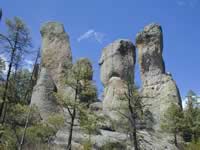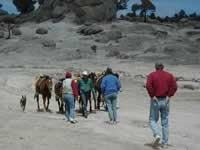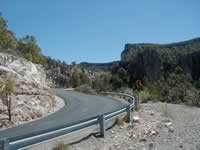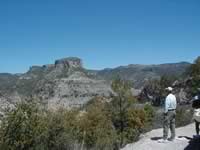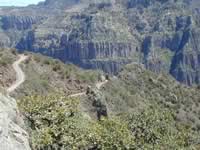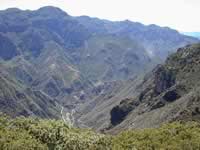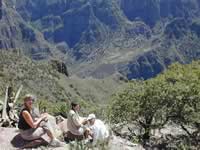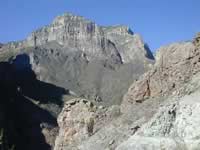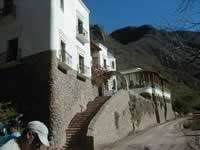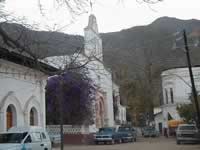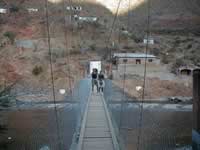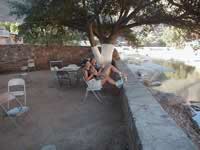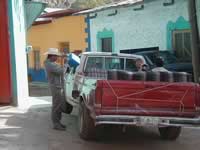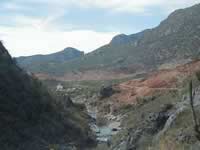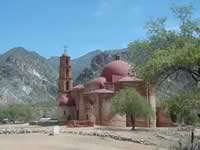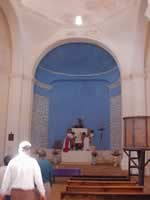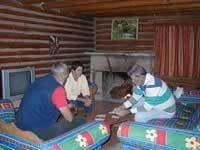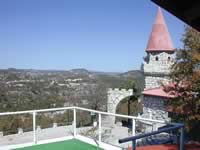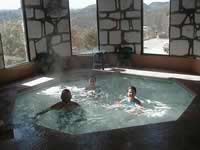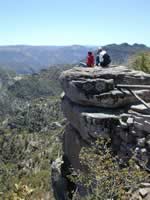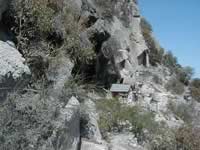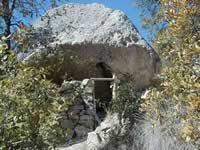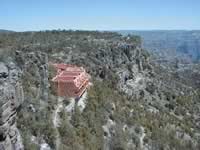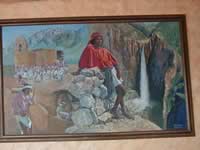HOME |
LOGBOOK |
| Volume
93 We just got back from a great one-week trip to Copper Canyon. For anyone moved by dramatic landscapes, Copper Canyon, in Mexico’s Sierra Madre Occidental (approximately 27*N; 107.5*W), has to be one of those “can’t miss” destinations of the world. What people mean when they refer to “Copper Canyon” is actually a network of five major canyons carved by six rivers out of an area four times larger than America’s better-known Grand Canyon (Lonely Planet). Or, they are thinking more pointedly about riding the famous Copper Canyon Railroad, (actually the Ferrocarril Chihuahua al Pacífic or ChePe (pronounced ChayPay)), whose 415 miles of scenic track scales about 8000’ of mountain with 39 bridges, 86 tunnels, and a turn so tight the train actually crosses over itself. The Copper Canyon region
would be better thought of as the Sierra Tarahumara, after the
indigenous peoples who have made their home
here for centuries. One of the most “unmixed” of tribes,
the Tarahumara maintain an isolated lifestyle, traditionally making
their home in caves that riddle the ridge tops and cliff faces,
farming maize on small plots of soil, and raising goats and cattle
in what nooks and crannies the landscape allows them. Nowadays
many Tarahumara have built simple log or adobe homes on ejidos (land cooperatives), where are also found churches and schools,
and many individuals are often seen selling crafts to tourists
in towns That it was a big canyon and a great train ride was about all we knew about Copper Canyon when we made plans last summer to make the trip with our friends Dennis and Lisa from Lady Galadriel this spring. Fortunately, several cruiser friends, who went last year and this, had prepped reports on their visits that helped us shape a general idea of the things we might want to do. Those, the Internet and a great book available called Mexico’s Copper Canyon by Richard D. Fisher (order from Sunracer Publications in Arizona; telephone 520-882-5341) fleshed out our anticipation. However, other than buying our early morning bus ticket the day before, we had no reservations or schedule in place before we left. Our plan was to go with the flow. The four of us left Mazatlán at 7a.m. April 1, by the TAP first class bus to Los Mochis. This was a six hour-long (three-movie) ride northward along flat coastal lands mostly devoted to agriculture. In Los Mochis, we schlepped our bags about six blocks in order to connect with a second class bus to the town of El Fuerte, two hours inland. We could have overnighted and caught the ChePe Express as it originated in Los Mochis, but El Fuerte was said to be a more charming town, not to mention a later departure time! This proved true.
The Rio Vista is perched on a cliff (mirador) tucked out of site behind the large fort (actually a replica of the original one) that gave the town its name. The hotel looks out over the surprisingly broad Rio Fuerte, which twists away westward. The bus ride had seemed so level, we were surprised to see mountains between us and the sunset. The rooms were quite attractive. One whole wall of ours was the rock the hotel had been built into, which extended right into the shower. Earlier cruisers had warned us that this hotel was plagued by vicious no-see-ums, but even though we sat through dusk watching the hummingbirds at the feeders, our bug juice worked and none of us were bitten. The hotel took us to
the train station the next morning to catch the eastbound primera
express, which is distinguished from the “clase
economica” train that follows by having a dining
car, making fewer stops and by being slightly more on time.
This is
Mexico,
and being on time is a relative thing. As we waited, the sky
grew grayer and grayer and a few drops of rain spotted the
pavement. By the time we were halfway up the mountain, a cold
drizzle had
set in. Lisa and I had worried about whether bad weather might
ruin the whole effect of the train ride up the gorges, but
in fact
we all agreed it was beautiful regardless. Only at Divisadero,
the stop where the train route actually approaches the main
canyon rim and where passengers are given ten minutes to disembark
and
ogle the view, were we robbed. Instead of a canyon vista, we
had a wall of gray fog! For many tourists, the train ride is the whole of their Copper Canyon trip. These folks ride the train one way either eastbound from Los Mochis to Chihuahua or westbound the other way. Imagine how disappointing the fog-out must have been to them! Many of the other travelers aboard were in large organized tour groups with a guide holding their hands the whole way. There was one such group in our car, and their guide narrated the scenery, bridges and tunnels sliding past the windows. The tour groups get a little closer experience than the train-only people by stopping over at two or three of a string of luxury hotels (www.mexicoscoppercanyon.com ) perched on the canyon rim itself, but its hard to imagine any of them venturing far from their hotel balconies. For the more adventurous
and lower budget travelers, however, the Copper Canyon really
comes into its own. There are hostels,
lodges and campgrounds all through the Canyon for less than a quarter
of the price of the luxury hotels. The major center for these is
Creel, a rugged looking village on the continental divide at about
7600’, where we got off the train in the rain. Again, we
had no plans or reservations, and just at that moment it seemed
a bleak prospect. As the crowd dispersed at the station we were
vigorously hustled by two boys thrusting forth brochures for the
Plaza Mexicana Margaritas. The Margaritas folks (sorry, I lost
the card with the And indeed, when the next day dawned bright, brisk and breezy, (we were each bundled up in 4-5 layers of clothes!), we had a hell of a time convincing the management that we were not going out on “Tour #1”. Actually, we did do “Tour #1”, but instead of the Margaritas’ van tour we went with Norberto (Beto) Padilla of Mexico by Horseback (www.ridemexico.com). Beto is an attractive young man who quite epitomizes the image of a Mexican caballero. He speaks English well and his horses are the same small, sturdy, sensible creatures we’ve seen throughout Central America, which are the only ones that survive the rough terrain. Believe me, we went several places that taxed my comfort zone that our horses stolidly coped with. The country around Creel is high-mountain pine forest pocked by complicated rock formations. The strange shapes are an attraction in themselves with some like mushrooms and others like frogs and, most impressive of all, the Valle de los Monjes, which is the polite name given to what the Tarahumara call Bisabírachi or “Valley of the Erect Penises.” Believe me, the Tarahumara have got it right. As we rode up hill and down, across fields and beneath whispering pines, we saw the Tarahumara about their daily lives plowing fields, tending goats, cutting wood in locations far from the main road. What better way to see this kind of countryside I cannot imagine. Our only mishap of the day occurred while we were inside the San Ignacio Mission. Although we were only inside for a few minutes, when we came out, no horses and no Beto!?!. A tour guide in a beat up station wagon started selling us his services, waving his hands like birds flying the coop. “Horses? Gone Creel. Horses…gone Creel!” It transpired that Beto had tried to nip into a tiny tienda for a soda, and in that second our ground tied horses got spooked and headed for home. Fortunately, it was early in the ride and “home” was at worst no more than a couple of miles back. We were still chuckling when Beto appeared around the corner leading five shamefaced horses. He had managed to snag the smallest, and thereby catch up with the others. In his arms he juggled an collection of our personal items, like binoculars and lunch makings, that had flown from the saddlebags! Of course, after six hours in the saddle (and the saddles were not made for our size butts), we were all fairly crippled up! So, the next day, we arranged with Margaritas for an overnight trip to Batopilas, a van tour six hours down into the depths of the canyon of the same name. We could have gone by the public bus, but seven hours in school bus seats was out of the questions for the three tall people in the group. Margaritas has their own, fairly new hotel there called La Hacienda Río Batopilas. This is a very handsome place in a whole different league than their rustic Creel properties, and yet they can’t be getting too much business, as it’s not easy place to get to! In fact, beside our driver and us, the hotel’s chef and hotel manager actually traveled down with us. It is an awesome trip. The road is paved the first three hours of the journey and it crosses the northern tips of several smaller canyons that are impressive in their own right. But it’s the 2000-meter descent into Barranca de Batopilas itself via a rugged dirt road making dozens of switchbacks with precipitous drops only inches away that is will be unforgettable. We stopped many times, for photos, for our box lunch, to change tires, and simply for Salvador, our driver, to get a break. Across the gorge ran the footpaths of the Tarahumara, linking small houses and farms perched in the most isolated of places. At one turn might be a Tarahumara couple knocking spines off nopales (edible cactus pads); in another a tethered steer, down the road a couple of donkeys grazing among a four place cemetery; and at the next turn a view of eight switchbacks below. Everywhere were the roadside shrines. Every time we passed one our driver crossed himself. The decent carried us through several climate and vegetative zones from pine forest to desert scrub until, when we stepped out in Batopilas we were back to balmy tropical conditions with bananas and palm trees. After just days up in Creel, where I’m quite sure the low temps were in the 40s, it was sure welcome to shed all our layers. The former silver mining town was surprisingly lively, strung out along a mile or so of river in the canyon bottom. Our hotel rooms were elegant with brass beds, antiques and in the bathrooms, clawfooted tubs and tiled basins. When we walked into town, people of all ages were markedly friendlier than those of Creel. Quickly we were sorry we weren’t staying longer. Early the next
morning Arturo, one of two Batopilas guides, collected us in
his pickup
truck equipped with two sofas facing each other
in the truck
Like the Franciscans,
the Jesuits had come to spread the word of God, but they also
came with their eye out for minerals, which
soon led to the
On Sunday morning we hopped a bus to backtrack down the train route a few stops to Posada Barrancas. Lisa and I, the planners of this whole jaunt, had maneuvered our expenditures to enable squandering one night in one of the high end luxury hotels built right on the canyon rim. However we were thwarted when a phone call from the bus station revealed that both our first choices, The Hotel Mirador and the Hotel Divisadero Barrancas, were full! We were referred to the Méson Tarahumara (www.online.com.mx/plaza/mansion). Also known as “El Castillo,” because it is built to look like a castle, the Méson Tarahumara turned out to be just on the other side of the ridge from the Mirador for about half the price. I’ll confess to a little prejudice about architecture that seems out of place like this, but it was more than counterbalanced by the hospitality of owner/manager Maria Barriga Villareal, their personable pack of dogs (who accompanied us everywhere) and, quite frankly, by the well-prepared meals. Our rooms were very nice in individual stone cabins featuring king-sized beds, and Dennis & Lisa had a TV with CNN that allowed us to catch up with the war news. The hotel even has a heated indoor pool and jacuzzi!
At last it was time to board the ChePe Express home. We boarded the train in mid-afternoon Monday and rode down in the Club Car playing cribbage all the way to Los Mochis. We stayed overnight in the least attractive of our hotels (El Fenix), where perversely we all got a very good nights sleep (despite the rumble and vibration of traffic and a non-stop compressor), and caught the 9am bus back to Mazatlan just one week after our departure. A few words in closing:
We made this trip in April. Probably the ideal time to come is
October and November when the summer’s
rains will have filled the streams and waterfalls and turned the
canyon vegetation bright green. Whenever you come, recognize that
the trip involves a great deal of time spent just getting from
one place to another. Fortunately, like much of our usual cruising,
the “getting there” is half the point. |
|
home
| waypoints | logbook | reference shelf
|

